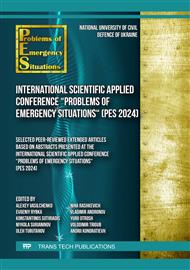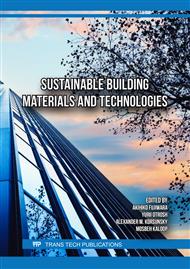[1]
L. Wang, A. Toppinen, H. Juslin, Use of wood in green building: a study of expert perspectives from the UK, J Clean Prod. 65 (2014) 350–361.
DOI: 10.1016/j.jclepro.2013.08.023
Google Scholar
[2]
H. Milner, A. Woodard, Sustainability of engineered wood products, Civil and Structural Engineering. (2016) 159–180.
Google Scholar
[3]
L. Wagner, C. Bos, T.K. Bader, K. De Borst, Effect of water on the mechanical properties of wood cell walls-results of a nanoindentation Study, BioResources. 10 (2015) 4011–4025.
DOI: 10.15376/biores.10.3.4011-4025
Google Scholar
[4]
E.E. Thybring, M., Kymäläinen, L. Rautkari, Moisture in modified wood and its relevance for fungal decay, iForest Biogeosci. 11 (2018) 418–422.
DOI: 10.3832/ifor2406-011
Google Scholar
[5]
E.E. Thybring, M. Fredriksson, Wood modification as a tool to understand moisture in wood, Forests. 12 (2021) 372.
DOI: 10.3390/f12030372
Google Scholar
[6]
Y. Tsapko, R. Likhnyovskyi, O. Horbachova, S. Mazurchuk, A. Tsapko, K. Sokolenko, A. Matviichuk, M. Sukhanevych, Identifying parameters for wood protection against water absorption, Eastern-European Journal of Enterprise Technologies. 6/10(120) (2022) 71–81.
DOI: 10.15587/1729-4061.2022.268286
Google Scholar
[7]
E. Keržič, B. Lesar, M. Humar, Influence of Weathering on Surface Roughness of Thermally Modified Wood, BioResources. 16(3) (2021) 4675–4692.
DOI: 10.15376/biores.16.3.4675-4692
Google Scholar
[8]
Y. Tsapko, O. Horbachova, S. Mazurchuk, Establishment of regularities of the influence of polymeric shell on wood biodegradation, Ukrainian Journal of Forest and Wood Science. 12(4) 2021 50–63.
DOI: 10.31548/forest2021.04.005
Google Scholar
[9]
B. Arminger, J. Jaxel, M. Bacher, W. Gindl-Altmutter, C. Hansmann, On the drying behavior of natural oils used for solid wood finishing, Progress in Organic Coatings. 148 (2020) 105831.
DOI: 10.1016/j.porgcoat.2020.105831
Google Scholar
[10]
K. Candelier, M. F. Thevenon, A. Petrissans, S. Dumarca, P. Gerardin, M. Petrissans, Control of wood thermal treatment and its effects on decay resistance: A review, Annals of Forest Science. 73 (2016) 571–583.
DOI: 10.1007/s13595-016-0541-x
Google Scholar
[11]
O. Espinoza, U. Buehlmann, M.F. Laguarda-Mallo, Thermally modified wood: Marketing strategies of U.S. producers, BioResources. 10(4) (2015) 6942–6952.
DOI: 10.15376/biores.10.4.6942-6952
Google Scholar
[12]
E. Roszyk, E. Stachowska, J. Majka, P. Mania, M. Broda, Moisture-dependent strength properties of thermally modified Fraxinus excelsior wood in compression, Materials. 13(7) (2020) 1647.
DOI: 10.3390/ma13071647
Google Scholar
[13]
Y. Tsapko, O. Horbachova, S. Mazurchuk, O. Bondarenko, Study of the efficiency of the adhesive layer for production from thermomodified wood, AIP Conference Proceedings. 2490(1) (2023) 050008.
DOI: 10.1063/5.0124507
Google Scholar
[14]
J.J. Weiland, R. Guyonnet, Study of chemical modifications and fungi degradation of thermally modified wood using DRIFT spectroscopy, Holz Roh Werkst. 61(3) (2003) 216–220.
DOI: 10.1007/s00107-003-0364-y
Google Scholar
[15]
M. Hakkou, M. Pétrissans, P. Gérardin, A. Zoulalian, Investigation of the reasons for fungal durability of heat-treated beech wood, Polym Degrad Stabil. 91(2) 2006 393–397.
DOI: 10.1016/j.polymdegradstab.2005.04.042
Google Scholar
[16]
Y. Tsapko, O. Horbachova, S. Mazurchuk, А. Tsapko, K. Sokolenko, A. Matviichuk, Determining Patterns In Reducing The Level Of Bio-Destruction Ofthermally Modified Timber After Applying Protective Coatings, Eastern-European Journal of Enterprise Technologies. 5(10-113) (2021) 48–55.
DOI: 10.15587/1729-4061.2021.242899
Google Scholar
[17]
G. Mantanis, Chemical modification of wood by acetylation or furfurylation: a review of the present scaled-up technologies, BioResources. 12(3) (2017) 4478–4489.
DOI: 10.15376/biores.12.2.mantanis
Google Scholar
[18]
A. Sandak, E. Földvári-Nagy, F. Poohphajai, R.H. Diaz, O. Gordobil, N. Sajinčič, V. Ponnuchamy, J. Sandak, Hybrid Approach for Wood Modification: Characterization and Evaluation of Weathering Resistance of Coatings on Acetylated Wood, Coatings. 11 (2021) 658.
DOI: 10.3390/coatings11060658
Google Scholar
[19]
J. Sandak, A. Sandak, I. Burud, Modelling of weathering, Performance of Bio-based Building Materials. (2017) 502–510.
Google Scholar
[20]
G. Beck, S. Strohbusch, E. Larnшy, H. Militz, C. Hill, Accessibility of hydroxyl groups in anhydride modified wood as measured by deuterium exchange and saponification, Holzforschung. 72 (2017) 17–23.
DOI: 10.1515/hf-2017-0059
Google Scholar
[21]
G. Grüll, F. Tscherne, I. Spitaler, B. Forsthuber, Comparison of wood coating durability in natural weathering and artificial weathering using fluorescent UV-lamps and water, Eur. J. WoodProd. 72 (2014) 367–376.
DOI: 10.1007/s00107-014-0791-y
Google Scholar
[22]
S. Himmel, C. Mai, Effects of acetylation and formalization on the dynamic water vapour sorption behaviour of wood, Holzforschung. 69(5) (2015) 633–643.
DOI: 10.1515/hf-2014-0161
Google Scholar
[23]
C.-M. Popescu, C.A.S. Hill, The water vapour sorption behaviour of acetylated birch wood: How acetylation affects the sorption isotherm and accessible hydroxyl content, Journal of Materials Science. 49(5) (2014).
DOI: 10.1007/s10853-013-7937-x
Google Scholar
[24]
D. Jones, C. Hill, M. Šernek, Wood modification – A brief overview of the technology, Materials Science. (2007) 1–9.
Google Scholar
[25]
R.M. Rowell, Handbook of Wood Chemistry and Wood Composites. 2nd Ed., CRC Press; Taylor and Francis Group, Boca Raton, Florida, USA, 2012, p.703.
Google Scholar
[26]
F. Bongers, J. Alexander, J. Marcroft, D. Crawford, R. Hairstans, Structural design with Accoya wood, International Wood Products Journal. 4(3) 2013 172–176.
DOI: 10.1179/2042645313y.0000000041
Google Scholar
[27]
P. Larsson-Brelid, Benchmarking and state-of-the-art report for modified wood, SP Report №54, Swedish Institute of Wood Technology SP, Stockholm, Sweden, (2013) 1–31.
Google Scholar
[28]
J. Guo, C. Wang, C. Li, Y. Liu, Effect of Acetylation on the Physical and Mechanical Performances of Mechanical Densified Spruce Wood, Forests. 13(10) (2022) 1620.
DOI: 10.3390/f13101620
Google Scholar
[29]
W.J. Homan, A.J.M. Jorissen, Wood modification developments, Heron. 49(4) (2004) 361–385.
Google Scholar
[30]
A. Papadopoulos, G. Pougioula, Mechanical behaviour of pine wood chemically modified with a homologous series of linear chain carboxylic acid anhydrides, Bioresource Technology. 101(15) (2010) 6147-50.
DOI: 10.1016/j.biortech.2010.02.079
Google Scholar
[31]
ISO 13061-2:2014 EN Physical and mechanical properties of wood – Test methods for small clear wood specimens – Part 2: Determination of density for physical and mechanical tests.
DOI: 10.3403/30406123u
Google Scholar
[32]
ISO 13061-13:2024 Physical and mechanical properties of wood – Test methods for small clear wood specimens – Part 13: Determination of radial and tangential shrinkage.
DOI: 10.3403/30406123
Google Scholar
[33]
BS EN 13183-1:2002 Moisture content of a piece of sawn timber. Determination by oven dry method.
DOI: 10.3403/02558468u
Google Scholar
[34]
DIN EN 408:2010 Timber Structures – Structural Timber And Glued Laminated Timber – Determination Of Some Physical And Mechanical Properties.
DOI: 10.3403/30159970
Google Scholar
[35]
A. Murr, Water vapour sorption and moisture transport in and across fibre direction of wood, Cellulose. 29 (2022) 4135–4152.
DOI: 10.1007/s10570-022-04520-x
Google Scholar
[36]
R. Simonson, R.M. Rowell, A new process for the continuous acetylation of wood fiber, 5th Pacific Rim Bio-Based Composite Symp. P.D. Evans, ed. Canberra, Australia. (2000). 190–196.
Google Scholar
[37]
Y. Tsapko, O. Horbachova, Use of a polymer shell of thermally modified wood to establish moisture diffusion patterns, Ukrainian Journal of Forest and Wood Science. 12(1) (2021) 41–47.
DOI: 10.31548/forest2021.01.005
Google Scholar
[38]
A. Pichette, X. Huang, D. Kocaefe, Y. Kocaefe, Combined effect of acetylation and heat treatment on the physical, mechanical and biological behavior of jack pine (Pinus banksiana) wood, European Journal of Wood and Wood Products. 76 (2018) 525–540.
DOI: 10.1007/s00107-017-1232-5
Google Scholar
[39]
H. Yin, R. Ringman, M.S. Moghaddam, M. Tuominen, A. Dėdinaitė, M. Wålinder, A. Swerin, S. Bardage, Susceptibility of surface-modified superhydrophobic wood and acetylated wood to mold and blue stain fungi, Progress in Organic Coatings. 182 (2023) 107628.
DOI: 10.1016/j.porgcoat.2023.107628
Google Scholar
[40]
A. Fojutowski, A. Koziróg, A. Kropacz, A. Noskowiak, The susceptibility of some acetylated hardwood species to mould fungi attack – An attempt to objectify the assessment, International Biodeterioration and Biodegradation. 86B (2014) 60–65.
DOI: 10.1016/j.ibiod.2013.08.007
Google Scholar
[41]
A.M.Y. Baufleur, D.M. Stangerlin, F.N. Gouveia, A.S.V.S. da SILVA, J.R.V. de OLIVEIRA, M.F. da SILVEIRA, A.S. Pimenta, R.R. de MELO, Resistance of acetylated Jacaranda copaia wood to termites and decaying fungi attack, Acta Amazonica. 52(3) (2022) 264–269.
DOI: 10.1590/1809-4392202200832
Google Scholar



